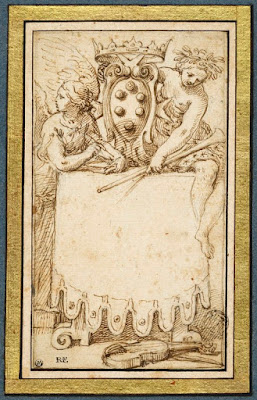 |
| Charles Le Brun Avenging Angels ca. 1672 drawing (figure studies for ceiling decoration at Versailles) Musée du Louvre |
"Hell from beneath is moved for thee to meet thee at thy coming: it stirreth up the dead for thee, even all the chief ones of the earth; it hath raised up from their thrones all the kings of the nations. All they shall speak and say unto thee, Art thou also become weak as we? art thou become like unto us? Thy pomp is brought down to the grave, and the noise of thy viols: the worm is spread under thee, and the worms cover thee. How art thou fallen from heaven, O Lucifer, son of the morning! how art thou cut down to the ground, which didst weaken the nations! For thou hast said in thine heart, I will ascend into heaven, I will exalt my throne above the stars of God: I will sit also upon the mount of the congregation, in the sides of the north: I will ascend above the heights of the clouds; I will be like the most High. Yet thou shalt be brought down to hell, to the sides of the pit."
– from the book of Isaiah, chapter 14 (King James Bible, 1611)
 |
| Charles Le Brun Fall of the Rebel Angels ca. 1672 drawing (figure studies for ceiling decoration at Versailles) Musée du Louvre |
 |
| Charles Le Brun Fall of the Rebel Angels ca. 1672 drawing (figure study for ceiling decoration at Versailles) Musée du Louvre |
 |
| Charles Le Brun Fall of the Rebel Angels ca. 1672 drawing (figure study for ceiling decoration at Versailles) Musée du Louvre |
 |
| Charles Le Brun Fall of the Rebel Angels ca. 1672 drawing (figure study for ceiling decoration at Versailles) Musée du Louvre |
 |
| Charles Le Brun Fall of the Rebel Angels ca. 1672 drawing (figure studies for ceiling decoration at Versailles) Musée du Louvre |
 |
| Charles Le Brun Fall of the Rebel Angels ca. 1672 drawing (figure study for ceiling decoration at Versailles) Musée du Louvre |
 |
| Charles Le Brun Fall of the Rebel Angels ca. 1672 drawing (figure study for ceiling decoration at Versailles) Musée du Louvre |
 |
| Charles Le Brun Fall of the Rebel Angels ca. 1672 drawing (figure study for ceiling decoration at Versailles) Musée du Louvre |
 |
| Charles Le Brun Fall of the Rebel Angels ca. 1672 drawing (figure study for ceiling decoration at Versailles) Musée du Louvre |
 |
| Charles Le Brun Fall of the Rebel Angels ca. 1672 drawing (figure studies for ceiling decoration at Versailles) Musée du Louvre |
 |
| Charles Le Brun Fall of the Rebel Angels ca. 1672 drawing (figure study for ceiling decoration at Versailles) Musée du Louvre |
 |
| Charles Le Brun Fall of the Rebel Angels ca. 1672 drawing (figure study for ceiling decoration at Versailles) Musée du Louvre |
 |
| Charles Le Brun Fall of the Rebel Angels ca. 1672 drawing (figure study for ceiling decoration at Versailles) Musée du Louvre |
 |
| Charles Le Brun Fall of the Rebel Angels ca. 1672 drawing (figure study for ceiling decoration at Versailles) Musée du Louvre |












































